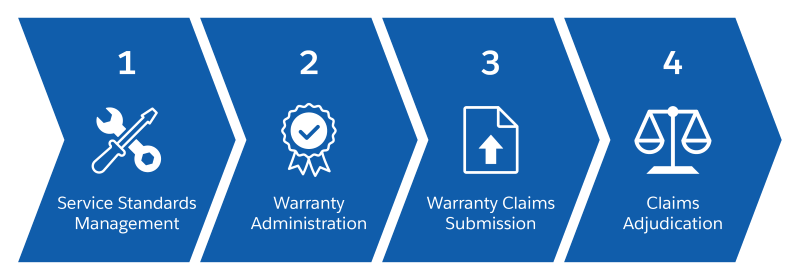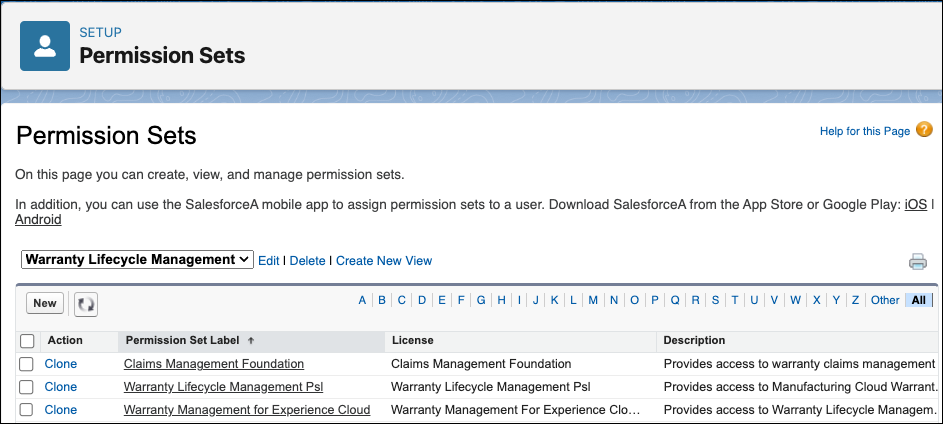Get Started with Warranty Lifecycle Management
Learning Objectives
After completing this unit, you’ll be able to:
- Outline the end-to-end lifecycle of warranties.
- Identify the personas involved in warranty administration and claims management.
- Describe the challenges of a typical warranty-management team at a manufacturer.
- Summarize the capabilities of Warranty Lifecycle Management in Manufacturing Cloud.
Nurture Relationships with Reliable Warranties
Customers are loyal to the prolonged value that products provide, not companies themselves. But products wear and break over time. How do companies ensure that their products will continue to deliver value in the long haul?
Warranties are an important way for companies to affirm the long-lasting value their products provide. A warranty is a written guarantee of a product's quality. It outlines the responsibility of a company to repair or replace defective products under certain conditions.

Warranties typically have a fixed duration and a type of coverage. They also define warranty entitlements, which are the support provided by the company to customers for defective products, such as replacements, repairs, and refunds. A warranty might be included with a product, purchased as an optional add-on, or added at a later date.
Many companies and individuals play a role in the warranty lifecycle. Here are the steps in the lifecycle of a typical warranty.
Every step of the warranty lifecycle has its own specialized processes, parties, and objectives. Collaboration, efficiency, and trust are must-haves for success in each step.
Put Yourself in a Manufacturer’s Shoes
Let’s zoom in to the warranty processes of manufacturers, a key part of the warranty lifecycle. The process includes warranty-service-standards management, warranty administration, warranty-claims capture, and warranty-claims-adjudication stages.

Today, creating a warranty process is more than a simple business imperative for manufacturers. It’s a way to cultivate deep relationships with partners, gain an edge in competitive markets, and nurture their brands. Plus, a manufacturer can provide a more holistic partner experience and drive servitization with an efficient, impactful warranty process.
But wait, the plot thickens. Building a robust warranty process can be more than a tad bit difficult for manufacturers. And that’s exactly the challenge Rayler Parts, an up-and-coming construction equipment manufacturer, is facing.
Rayler’s current warranty process is sluggish and inflexible. It relies on antiquated systems, manual workflows, and lots of paperwork. Cindy Jones, the Salesforce administrator, knows it’s time for a process revamp. To grasp their pain points, she reaches out to the key stakeholders:
-
Abhijeet Thaler is the warranty administrator at Rayler Parts.
-
Kendrick Miranda is a warranty claims adjudicator at Rayler Parts.
-
Ore Ngozi is a warranty claims clerk at Danubelle Distributors, which works closely with Rayler Parts.
Cindy evaluates their challenges and foresees an uphill battle ahead to find a solution. But for Cindy, where there's a will, she finds a way.
Meet the Warranty Powerhouse
As you may have learned in the Manufacturing Cloud Basics module, Rayler Parts uses Manufacturing Cloud to manage commercial operations, orchestrate the service experience, and coordinate closely with its partners. Cindy connects with the Salesforce account executive for Rayler Parts to see if Manufacturing Cloud offers a way to overhaul the warranty process.
Cindy’s in luck. The account executive introduces Warranty Lifecycle Management, a capability of Manufacturing Cloud. It’s a solution that empowers manufacturers to build a versatile, end-to-end warranty process—from warranty administration to claims collection and adjudication. Manufacturers can create a comprehensive framework of warranty rules and entitlements, elevate claims processing efficiency, and supercharge the warranty team’s productivity.
Cindy is curious to learn more about Warranty Lifecycle Management. The account executive walks her through how it can help Rayler meet challenges across the different stages of the warranty lifecycle.
Warranty Service Standards Management
Warranty administrators like Abhijeet establish standard codes to describe product defects, labor services, expenses, and other service operations. For example, they create labor codes to standardize the definitions of a specific labor service.
Here are the main issues manufacturers face while defining and managing warranty service standards.
Challenge |
Warranty Lifecycle Management Solution |
|---|---|
A lack of comprehensive service standards leads to discrepancies in payouts and ambiguous warranty guidelines. |
Warranty admins can define code sets for service operations and apply the code sets consistently across operations. |
With the large number of products and services, it’s complex to track all the services that can be performed for different products. |
Warranty admins can associate product fault codes with product labor codes to map the services needed to rectify defective products. |
Warranty Administration
Warranty admins define the entitlements, eligibility conditions, and duration of a warranty term. They assign warranties to products, and they specify extensions, restrictions, and void terms for coverages.
Here are key problems manufacturers encounter while administering warranties.
Challenge |
Warranty Lifecycle Management Solution |
|---|---|
Warranty admins struggle to define differentiated warranty terms for various products and product families. |
They can create and maintain a comprehensive, detailed framework of warranty terms at multiple product levels. |
Vague and inconsistent warranty entitlements lead to revenue leakage and subjectivity in claims adjudication. |
They can clearly define labor, parts and expenses covered, and exchange options and exclusions. |
Extensions and restrictions in warranties for specific products are recorded in rough notes and purchase receipts. |
They can systematically capture extensions, restrictions, and void terms for product warranties. |
Warranty Claims Submission
After partners or distributors fix product issues, they submit a claim to the manufacturer to be reimbursed for expenses incurred on labor services, part replacements, or other costs. Claim clerks at partners and distributors review rectified products, examine warranty terms, submit warranty claims, and follow up on pending claims.
Claims clerks like Ore often experience several pain points while submitting claims.
Challenge |
Warranty Lifecycle Management Solution |
|---|---|
Partners can’t easily check warranty guidelines while submitting claims. |
They can use an online portal to view warranty rules and coverage information. |
Partners struggle to track the status of their warranty claims. |
The online portal allows them to closely track their claims and approved amounts. |
Insufficient and inaccurate claims information leads to unnecessary partner follow-ups and erroneous claims adjudication. |
Partners can submit claims with granular details about defective products, existing coverages, expenses incurred, and more. |
Warranty Claims Adjudication
When a manufacturer receives a warranty claim from a partner, Kendrick and other warranty claims adjudicators must scrutinize the claim, authenticate the claimed expenses, and determine approved payouts. They have to verify the coverage of the warranty, solicit clarifications from the partner, and adjudicate the claim.
Let’s dive into challenges with claims adjudication.
Challenge |
Warranty Lifecycle Management Solution |
|---|---|
The volume and complexity of warranty claims lead to high processing times. |
Admins can use the process-automation tools to quickly build claims adjudication processes. |
It’s cumbersome to modify or extend existing adjudication processes based on changing business needs. |
Business users can define and change claims adjudication rules with no-to-low code process-automation tools. |
It’s laborious to consolidate the required claims information from disparate systems. |
Claim adjudicators have a unified view of claim information, including defective assets, existing coverages, and expenses incurred. |
Cindy is floored. Warranty Lifecycle Management can help Rayler Parts build an incredible warranty process, and then some.
Get Up and Running
Cindy is pumped to get started. She begins by enabling Warranty Lifecycle Management in Rayler Parts’ org. Here’s the Warranty Lifecycle Management setup page in Setup.

Next, Cindy assigns the appropriate permission sets to the stakeholders.
Assigned To |
Permission Set |
|---|---|
Abhijeet Thaler |
|
Kendrick Miranda |
|
Ore Ngozi |
|
Take a look at the permission sets in Setup.

We have lift-off! In the upcoming unit, follow Abhijeet as he administers product warranties.
Resources
- Salesforce Help: Learn About Warranty Lifecycle Management
- Trailhead: Manufacturing Cloud Basics
- Salesforce Help: Introduction to Manufacturing Cloud